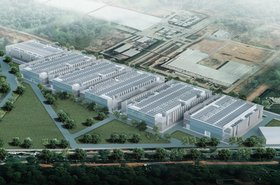India's data center ecosystem is undergoing a significant transformation, moving beyond traditional metropolitan hubs and expanding into Tier II, Tier III, and even Tier IV cities. This shift is fueled by the increasing demand for faster, more accessible digital services, the rapid growth of Edge computing, and government policies supporting the development of nationwide digital infrastructure.
As digital penetration deepens in smaller cities, there is a pressing need to decentralize data processing to enhance performance, reduce latency, and ensure seamless connectivity. Expanding data centers into smaller cities is not merely about addressing the digital needs of under served regions; it also helps tackle critical challenges such as data localization, energy efficiency, and cost management. These cities offer lower real estate, labor, and operational costs, making them attractive for data center investments.
Additionally, government incentives encourage infrastructure development, fostering economic growth in emerging locations. This strategic move enables a balanced digital ecosystem, ensuring connectivity across diverse regions while promoting economic opportunities.
Key drivers behind the shift to geographic diversity in data centers
Historically, India's data center infrastructure has been concentrated in major metros like Mumbai, Chennai, Bengaluru, Hyderabad, and Delhi. However, with the surging demand for real-time data processing and uninterrupted digital access, Tier II and Tier III cities are becoming focal points for data center expansion. Companies like CtrlS are leading this shift by deploying edge data centers in smaller cities, emphasizing the growing need for a geographically distributed network.
Factors propelling the transition
Reduced latency: Proximity to end-users is crucial in an era where digital applications demand real-time data processing. Sectors such as OTT streaming, gaming, and AI require ultra-low latency for seamless user experiences. Edge data centers in Tier II and Tier III cities bring computing power closer to consumers, significantly reducing response times and enhancing digital service performance.
Cost efficiency: Compared to metropolitan areas, the operational costs in Tier II and Tier III cities are significantly lower. Affordable real estate, lower labor expenses, and reduced power costs make these locations attractive for data center expansion. This cost-effectiveness allows operators to invest in cutting-edge infrastructure while maintaining financial viability.
Data localization compliance: With increasing concerns around data privacy and security, regulatory frameworks now mandate companies to store and process data within national borders. Establishing data centers in smaller cities enables organizations to comply with these mandates while ensuring that regional users' data remains geographically close, optimizing both security and performance.
Government initiatives: The Indian government, alongside various state bodies, has launched multiple initiatives to promote data center investments in emerging cities. A key example is RailTel's initiative to establish edge data centers at 102 railway locations, including Tier II and Tier III towns. Additionally, states such as Uttar Pradesh have introduced policies offering subsidies, dual power grid supplies, and other incentives to make data center expansion financially viable.
Opportunities in emerging sectors
As digital infrastructure expands into smaller cities, industries like e-commerce, healthcare, education, and fintech are increasingly targeting these regions to tap into the growing user base. This shift presents significant opportunities for data centers to support businesses that seek to provide digital services in previously underserved areas. With the demand for reliable data infrastructure surging, these emerging markets will play a pivotal role in India's digital transformation.
Challenges for data center expansion in smaller cities
While the growth of data centers in Tier II and Tier III cities presents numerous advantages, there are also distinct challenges that must be addressed:
Infrastructure and connectivity constraints: Inconsistent power supply and limited UG fiber connectivity remain significant hurdles. However, data center operators are actively collaborating with local governments and telecom providers to develop robust infrastructure and ensure uninterrupted service availability.
Skilled workforce availability: Establishing data centers requires a pool of skilled professionals proficient in IT infrastructure and data management. To bridge this talent gap, companies are partnering with educational institutions and government agencies to implement training programs and create job opportunities for local talent.
Market demand and ROI concerns:
- Lower demand: Unlike metro cities, demand from hyperscalers and large enterprises may be lower, impacting revenue potential.
- Capex justification: High upfront investment may not be justified unless there is a strong use case (e.g. edge computing, BFSI, government projects).
Logistics and supply chain issues:
- Hardware procurement delays: Importing or transporting critical equipment may take longer due to limited logistics infrastructure.
- Vendor availability: Fewer local vendors for maintenance, security, and facility management.
Limited ecosystem and peering networks:
- Lack of network presence: Fewer ISPs and network providers may lead to higher bandwidth costs.
- Absence of cloud and CDN nodes: Data localization laws may drive demand, but lack of local cloud/CDN nodes can impact latency-sensitive applications and add to the overall cost of the network.
Perception and awareness issues:
- Customer hesitation: Local small and medium enterprise reluctance to migrate workloads to a data center often stems from a lack of awareness about its benefits. Additionally, local IT managers may resist the transition, fearing job displacement as on-premise workloads shift to external facilities.
Lack of investor confidence: Investors may be hesitant due to uncertain demand and slower returns.
Overcoming these challenges requires strategic partnerships with local governments and ICT companies to develop sustainable solutions that support long-term data center growth.
Government policies and private investments: A collaborative approach
Both central and state governments are playing an instrumental role in fostering a favorable environment for data center expansion. Policies offering incentives, tax benefits, and real estate subsidies are encouraging private sector investments in smaller cities.
Companies such as CtrlS have taken a proactive stance, already operating centers in cities like Patna and Lucknow, with plans to establish over 20 Edge data centers across Tier II and Tier III locations.
Other players are also following suit, and planning facilities in smaller cities. These initiatives demonstrate the synergy between government support and private investment in shaping a resilient digital ecosystem beyond metros.
Sustainability and green data centers
Tier II and Tier III cities present a unique opportunity for the development of sustainable, eco-friendly data centers. The availability of land in these regions enables the implementation of green infrastructure, incorporating renewable energy sources such as solar and wind power. Advanced cooling techniques and energy-efficient designs align with India's sustainability goals, reducing carbon footprints and promoting responsible digital expansion.
The future of data centers in Tier II and Tier III cities
The decentralization of data centers into Tier II and Tier III cities marks a transformative phase in India's digital landscape. By fostering a distributed data infrastructure, these cities are emerging as key players in building a more resilient and efficient digital ecosystem.
The collaboration between government bodies, private enterprises, and local communities will be essential in unlocking the full potential of these regions. As data-driven industries continue to expand, India's smaller cities will play a vital role in driving innovation, economic growth, and a digitally empowered future.
More from CtrlS
-

CtrlS launches data center park in Chennai, India
Second facility set live, completes the campus
-

CtrlS completes 125MW solar farm to power Mumbai campus
Will cover 60 percent of energy consumption at the Mumbai campus
-

CtrlS to build 40-acre data center campus near Hyderabad, India
Company's fourth facility in Telangana state


